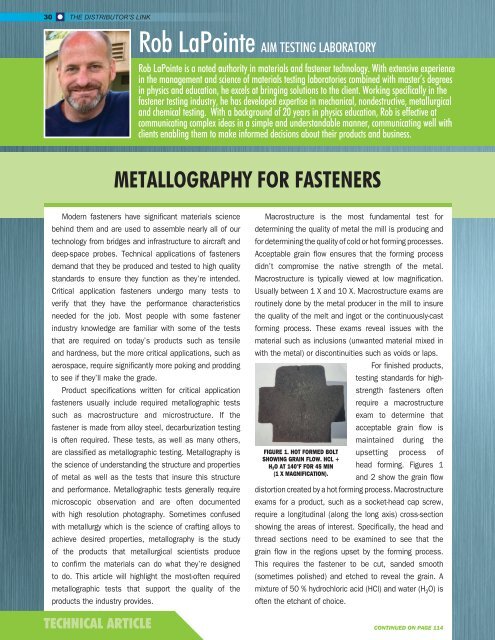SPRING 2019
Distributor's Link Magazine Spring 2019 / Vol 42 No2
Distributor's Link Magazine Spring 2019 / Vol 42 No2
Create successful ePaper yourself
Turn your PDF publications into a flip-book with our unique Google optimized e-Paper software.
30<br />
THE DISTRIBUTOR’S LINK<br />
Rob LaPointe AIM TESTING LABORATORY<br />
Rob LaPointe is a noted authority in materials and fastener technology. With extensive experience<br />
in the management and science of materials testing laboratories combined with master’s degrees<br />
in physics and education, he excels at bringing solutions to the client. Working specifically in the<br />
fastener testing industry, he has developed expertise in mechanical, nondestructive, metallurgical<br />
and chemical testing. With a background of 20 years in physics education, Rob is effective at<br />
communicating complex ideas in a simple and understandable manner, communicating well with<br />
clients enabling them to make informed decisions about their products and business.<br />
METALLOGRAPHY FOR FASTENERS<br />
Modern fasteners have significant materials science<br />
behind them and are used to assemble nearly all of our<br />
technology from bridges and infrastructure to aircraft and<br />
deep-space probes. Technical applications of fasteners<br />
demand that they be produced and tested to high quality<br />
standards to ensure they function as they’re intended.<br />
Critical application fasteners undergo many tests to<br />
verify that they have the performance characteristics<br />
needed for the job. Most people with some fastener<br />
industry knowledge are familiar with some of the tests<br />
that are required on today’s products such as tensile<br />
and hardness, but the more critical applications, such as<br />
aerospace, require significantly more poking and prodding<br />
to see if they’ll make the grade.<br />
Product specifications written for critical application<br />
fasteners usually include required metallographic tests<br />
such as macrostructure and microstructure. If the<br />
fastener is made from alloy steel, decarburization testing<br />
is often required. These tests, as well as many others,<br />
are classified as metallographic testing. Metallography is<br />
the science of understanding the structure and properties<br />
of metal as well as the tests that insure this structure<br />
and performance. Metallographic tests generally require<br />
microscopic observation and are often documented<br />
with high resolution photography. Sometimes confused<br />
with metallurgy which is the science of crafting alloys to<br />
achieve desired properties, metallography is the study<br />
of the products that metallurgical scientists produce<br />
to confirm the materials can do what they’re designed<br />
to do. This article will highlight the most-often required<br />
metallographic tests that support the quality of the<br />
products the industry provides.<br />
TECHNICAL ARTICLE<br />
Macrostructure is the most fundamental test for<br />
determining the quality of metal the mill is producing and<br />
for determining the quality of cold or hot forming processes.<br />
Acceptable grain flow ensures that the forming process<br />
didn’t compromise the native strength of the metal.<br />
Macrostructure is typically viewed at low magnification.<br />
Usually between 1 X and 10 X. Macrostructure exams are<br />
routinely done by the metal producer in the mill to insure<br />
the quality of the melt and ingot or the continuously-cast<br />
forming process. These exams reveal issues with the<br />
material such as inclusions (unwanted material mixed in<br />
with the metal) or discontinuities such as voids or laps.<br />
For finished products,<br />
testing standards for highstrength<br />
fasteners often<br />
require a macrostructure<br />
exam to determine that<br />
acceptable grain flow is<br />
maintained during the<br />
FIGURE 1. HOT FORMED BOLT upsetting process of<br />
SHOWING GRAIN FLOW. HCL +<br />
H 2 O AT 140°F FOR 45 MIN head forming. Figures 1<br />
(1 X MAGNIFICATION).<br />
and 2 show the grain flow<br />
distortion created by a hot forming process. Macrostructure<br />
exams for a product, such as a socket-head cap screw,<br />
require a longitudinal (along the long axis) cross-section<br />
showing the areas of interest. Specifically, the head and<br />
thread sections need to be examined to see that the<br />
grain flow in the regions upset by the forming process.<br />
This requires the fastener to be cut, sanded smooth<br />
(sometimes polished) and etched to reveal the grain. A<br />
mixture of 50 % hydrochloric acid (HCl) and water (H ²<br />
O) is<br />
often the etchant of choice.<br />
CONTINUED ON PAGE 114

















